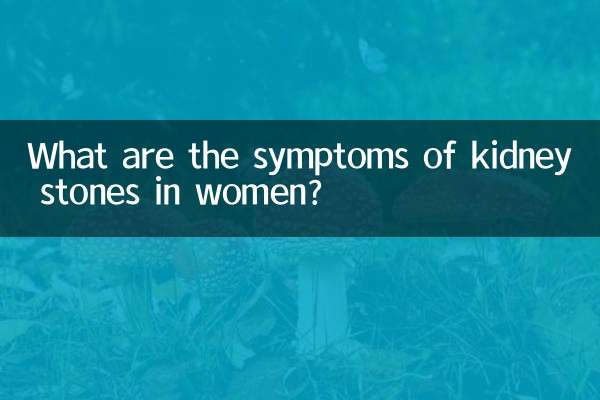How to determine what kind of spots are on the face?
Spots on the face are a problem for many people, and different types of spots and pigmentation can be caused by different causes. Only by understanding the type and cause of spots can we provide targeted treatment and care. This article will combine the hot topics and hot content on the Internet in the past 10 days to provide you with a detailed analysis of how to determine the type of spots on your face.
1. Common spot types and characteristics

According to the analysis of dermatologists and discussions among netizens, spots on the face are mainly divided into the following types:
| Spot type | feature | Common parts | Cause |
|---|---|---|---|
| freckle | Small, light brown spots with clear borders | bridge of nose, cheeks | Genetics, UV exposure |
| chloasma | Large brown or gray-brown patches with blurred borders | Cheekbones, forehead, upper lip | Hormone changes, UV rays, stress |
| sunburn | Round or irregularly shaped dark brown spots | Face, back of hands, arms | long term UV exposure |
| age spots | Flat, brown or black, rough surface | Face, back of hands, forearms | Aging, skin aging |
| post-inflammatory pigmentation | Brown or grayish-brown patches | After acne or wounds have healed | Skin inflammation, trauma |
2. How to self-judge the type of spots?
1.Observe the color and shape of the spots:Freckles are usually small and light, while sun spots are darker and irregularly shaped. Chloasma often appears in large patches with blurred borders.
2.Note the distribution of spots:Freckles are mostly concentrated on the bridge of the nose and cheeks, while chloasma is more common on the cheekbones, forehead and upper lip. Age spots often appear on exposed areas such as the back of the hands and forearms.
3.Review when spots appear:Freckles mostly appear in childhood, while sun spots and age spots gradually appear with age. Melasma often occurs during pregnancy or while taking birth control pills.
4.Analyze possible causes:If you have recent sun exposure, it may be sunburn; if you have a history of acne or skin trauma, it may be post-inflammatory pigmentation.
3. Inventory of popular freckle removal topics in the past 10 days
| hot topics | Discussion popularity | core ideas |
|---|---|---|
| Increased spots on "mask face" | high | Wearing a mask for a long time leads to a local hot and humid environment, which may aggravate chloasma |
| Summer sun protection and anti-spot tips | extremely high | Physical sunscreen + chemical sunscreen work together to prevent the formation of sun spots |
| Internet celebrity freckle removal product reviews | middle | Experts warn: Some products contain hormones, and long-term use may aggravate spots. |
| Aftercare for laser freckle removal | high | Strict sun protection and moisturizing after surgery are the key to avoiding anti-darkness |
| Internal adjustment freckle removal recipe | middle | Foods rich in vitamins C and E help inhibit melanin production |
4. Professional diagnostic suggestions
Although self-observation can initially determine the type of spot, accurate diagnosis still requires the help of a professional dermatologist. It is recommended to seek medical treatment promptly in the following situations:
1. The spots suddenly become larger, darker in color or change in shape
2. The spots are accompanied by itching, pain or bleeding
3. No improvement after self-care for more than 3 months
4. Not sure about the type of spot and need professional treatment plan
5. Care strategies for different types of spots
| Spot type | Daily care focus | Professional treatment options |
|---|---|---|
| freckle | Use strict sun protection and use skin care products containing vitamin C | Laser treatments, chemical peels |
| chloasma | Avoid irritation, use gentle skin care, and regulate endocrine | Drug therapy (hydroquinone, tretinoin), low-energy laser |
| sunburn | High-power sun protection, antioxidant care | Intense pulsed light, laser therapy |
| age spots | Anti-aging care to keep skin moisturized | Cryotherapy, laser removal |
| post-inflammatory pigmentation | Avoid irritating the affected area and use repair products | Chemical peels, microneedling treatments |
6. Daily precautions to prevent spots from getting worse
1.Year-round sun protection:Ultraviolet rays are the cause of most spots, so you should use sunscreen products with SPF30 or above even on cloudy days.
2.Gentle skin care:Avoid over-cleansing and using harsh products to reduce the risk of damaging your skin barrier.
3.Regular schedule:Ensure adequate sleep, reduce stress, and avoid exacerbation of chloasma caused by endocrine disorders.
4.A balanced diet:Eat more foods rich in vitamins C, E and antioxidants to inhibit melanin production.
5.Use medication with caution:Certain medications may increase photosensitivity, and you should consult your doctor before use.
Through the above analysis and suggestions, I hope you can initially judge the type of spots on your face and take appropriate care measures. Remember, when the spot problem is serious, it is the wisest choice to seek help from a professional dermatologist in time.

check the details

check the details